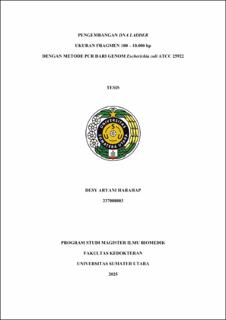| dc.description.abstract | Reference standards are very important in scientific investigations for producing accurate, reproducible, and quantitative data. One key reference standard in biomolecular laboratories is DNA ladder, which comprises a range of DNA fragments of various sizes. In the electrophoresis workflow, DNA ladder acts as a reference point to determine the size of DNA fragments of unknown length, rendering it a crucial reagent in biomolecular laboratories. In Indonesia, following the COVID-19 pandemic, there has been an increase in the number of laboratories working with PCR, accompanied by a rise in studies utilizing PCR. The routine application of PCR has led to an increased demand for DNA ladders, which are generally imported requiring significant time and financial resources. This study aims to produce 100 bp and 1 kb DNA ladders using PCR and to test their stability by adding a stabilizing buffer. DNA from Escherichia coli ATCC 25922 was extracted and used as a template for PCR. A total of 17 primer pairs, designed to amplify 17 DNA fragments, were generated using the NCBI Primer-BLAST tool. The PCR amplification results were visualized by agarose gel electrophoresis and were measured by a spectrophotometer. To produce the DNA ladder, the amount of each DNA fragment was adjusted, mixed, and then compared with a commercial DNA ladder. The 100 bp DNA ladder was stored in four different buffers—namely, Tris 10 mM/EDTA 10 mM, Tris 10 mM/EDTA 1 mM, Tris 10 mM/EDTA 0.1 mM, and nuclease-free water—for 3 months at -20 °C to assess qualitative stability. This study successfully produced 100 bp and 1 kb DNA ladders with visualization comparable to that of commercial DNA ladders. The designed primers were successful in amplifying DNA fragments of the desired sizes. All fragments in the homemade DNA ladders remained stable for up to 3 months. The four tested buffers preserved the quality of the homemade DNA ladders. The method presented in this study can produce DNA ladders that match the quality of commercial offerings and mantains stability for a duration of three months | en_US |


